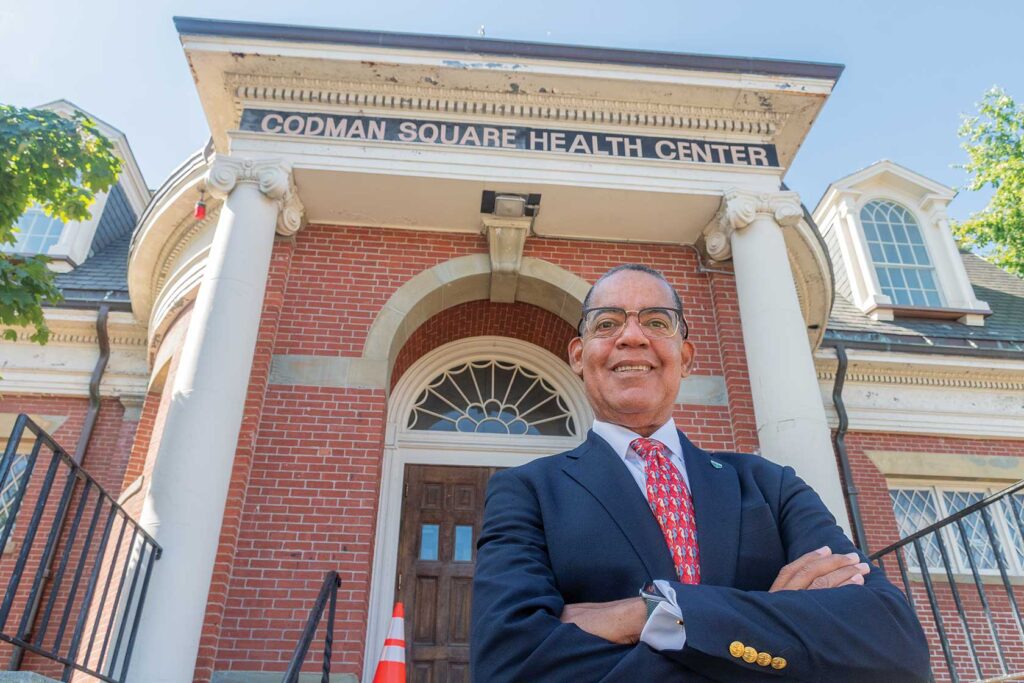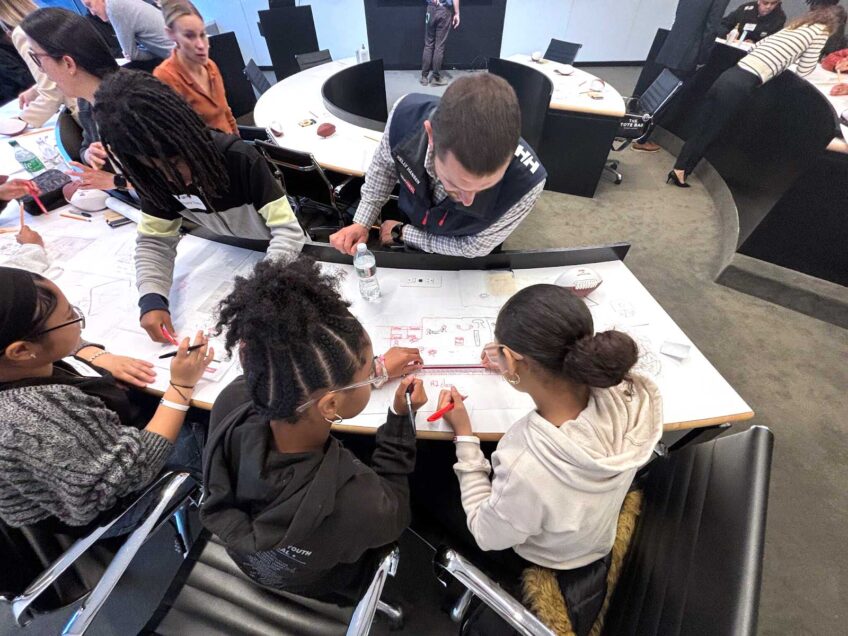New CEO takes the reins at Codman Square Health Center
Work toward Randolph expansion, prep for Carney Hospital closure top of mind for Dr. Guy Fis

Over the past 13 years, under the leadership of Sandra Cotterell, the Codman Square Health Center saw strong growth in its budget and operations.
Now, with Cotterell’s long-planned retirement, the center’s new CEO, Dr. Guy Fish — only the third CEO in the center’s history — is looking to keep up that momentum as he takes the helm.
Fish said he’s devoted to the “community” aspect of the community health center’s mission.
“We’re not for poor people, we’re not for people who have no other option,” Fish said. “We’re for everyone who walks through the door [and for] delivering high-quality care as good or better than what you would find in any other primary care practice.”
Top of mind right now is an ongoing expansion for the health center into Randolph, starting with a satellite clinic at Randolph High School but looking to further develop a full-fledged center there.
That push comes from a limited access to care in the Randolph area — no community health centers are located in the city and the nearest hospitals are about 15 to 20 minutes away — as well as a response to seeing community members from Dorchester move to Randolph and other South Shore municipalities with pressures from gentrification in Boston.
The satellite clinic will begin with four exam rooms, but Cotterell said that it will serve as a jumping-off point for further work.
“Given the demands in that community, it’s probably not a lot, but it’s a starting point for us,” she said. “I think that starting there and being a resource for that community is going to be phenomenal.”
At its current Dorchester location, the center is also expected to see changes following a year-long strategic plan that was developed as Cotterell planned her departure.
The planning effort included assessment of the community the health center serves and the community’s needs, as well as of the organization’s operations and capabilities.
“That allows Dr. Fish and even all of the leaders at the health center to really get to know, from a data perspective, who are we? What are we seeing? What are our strengths? What are our weaknesses? Where are things that we can improve?” Cotterell said.
She pointed to highlights from the assessments, like a determination that the health center can do more to help train and educate staff, take steps around operation efficiency to increase revenue, and simply revisit how to ensure that the patient is at the center of everything as the organization manages its model of care.
Now, she said, the leadership team is working to develop those assessments into specific, implementable action items.
Fish hopes to accomplish the goals by applying a skillset from his diverse background and career path.
A broad skillset
He began his career with a medical practice in rural Delaware, but has since worked in venture capital, worked on Wall Street and served as CEO of an artificial intelligence company. Most recently, he led Greater Lawrence Family Health Center under a three-year contract that ended in July. He said he thinks his broad spectrum of experiences will help him build new partnerships for the organization and keep it moving on its upward trajectory.
“My background is health care consulting and strategy — I did that for more years that I probably should have,” he said. “With that comes a penchant for deep analysis and understanding from an analytical framework, you know, where are we and where do we want to go?”
Cotterell said she’s excited to see how Fish applies his background to the work, as well as how he builds on the resources and structure left for him.
“I think that with his skills and his background and his knowledge of community health centers, I think he’ll do a good job with [taking the center to the next level],” she said. “He’s got a great foundation to work with, so, continuing to build upon that will be fun to watch.”
As he takes over, Fish said he’s looking forward to building relationships with community organizations and leaders — conversations and meetings he said he hopes to begin within the next few weeks or months as he settles into the role.
“There’s always been the ability of a community health center to look at what’s here in the community and what the needs are, and address those through partnerships and programs, but most importantly, by really talking to the community and asking what do what do you need? What do we need to deliver to make your lives better?” he said. “That’s the opportunity here at Codman that makes me so excited.”
He’ll have Cotterell as a guide. The outgoing CEO said one of her goals is to make sure Fish gets to meet the partners that help anchor the health center.
“They’ve been key in our delivery model and how we work, and really an extension of our resources to the community,” she said.
Codman Square Health Center has a host of partnerships in the surrounding area and within its facilities, including the nonprofit grocery Daily Table; Healthworks Community Fitness, a nonprofit focused on fitness opportunities for women and children; and Codman Academy Charter Public School, which shares a building with the center’s clinical space. Many of the center’s partnerships were started or grew under Cotterell’s leadership.
Carney closure aftermath
The transition is not all peachy for Fish. His move into the organization’s top role comes as Codman, along with other local community health centers, brace for increased demand with the closure of nearby Carney Hospital, just under a mile away, which officially shut its doors Aug. 31 after an approximately month-long expedited closure process after its owner, Steward Health Care, declared bankruptcy.
“We are looking at this as a crisis, as a health emergency,” he said. “When access to services is suddenly gone, those patients don’t disappear. They shift to the next available [resource]. Carney hospital is 0.8 miles from right here. We’re at the epicenter.”
In anticipating the increased need at Codman, Fish said he and other leadership are looking to expand capacity — an effort focused mostly on staffing, as the center has the physical space and services to serve more patients.
That means increasing numbers not just among the center’s doctors, but also the rest of the staff — nurses, medical assistants and others — to make sure the whole system can run smoothly.
“All of those have to come together,” he said. “You can’t just put a doc in a box and expect the magic to happen.”
Accounting for all their salaries and benefits, in an ecosystem where health centers are already sometimes hard pressed to just break even, poses its own challenges.
Responding to the closure is also a matter of identifying what services they can provide, while connecting patients with the ones they can’t.
“People show up at Carney Hospital’s emergency department with all kinds of conditions, from sniffles to heart attacks. When that closes, it’s not like the heart attacks are going to go away,” Fish said. “We are not staffed, equipped or capable of handling heart attack patients here, so we have to recognize them quickly and get them to the care that they need as quickly as possible.”
As the state moves forward and Steward Health Care moves out, Fish said he hopes that in the same way financial support is going to the Steward hospitals that are remaining open, the community around Carney Hospital — along with Nashoba Valley Medical Center in Ayer, which also closed Aug. 31 — are not forgotten.
On Aug. 29, the sale of four of the remaining Steward hospitals was finalized in the Dallas-based federal court that has been overseeing the bankruptcy proceedings.
Those signed deals included the purchase of St. Anne’s Hospital in Fall River and Morton Hospital in Taunton by the Rhode Island-based health system Lifespan, and the Methuen and Haverhill campuses of Holy Family Hospital by Lawrence General Hospital.
The following day, the state announced that a deal was signed to transfer ownership of Good Samaritan Medical Center in Brockton to Boston Medical Center.
The official sale of St. Elizabeth’s Medical Center in Brighton, also to Boston Medical Center, is still in progress, but as of Aug. 30, the state said that a deal had been reached between Steward Health Care and Boston Medical Center to transfer operations, while the state pursues taking the land — which is owned by a separate landlord — by eminent domain.
As part of those deals, the Healey-Driscoll Administration is directing $42 million to the transition of the six hospitals on top of $30 million the administration has already provided. According to reporting by the Boston Globe, the acquisitions, repairs and support to the hospitals could cost the state, federal government and other Massachusetts hospitals as much as $700 million by 2027.
Seeking equal treatment
Fish said he’d like to see some support go to organizations left in the community that will bear the brunt of the displaced patients and more limited medical resources.
“I’m seriously hoping that as the state works out supporting the five hospitals which are going to remain open with some capital … that there is also a rational, economic, political and moral justification for putting some monies into the two communities that where the hospitals are closing, so that it is not an abrupt stoppage of healthcare access,” Fish said.
Fish didn’t have a specific vision for what that support should look like or how it should be done, but he said that the communities risk being left behind.
“We really do need equal treatment in this community as is being delivered in others with the hospitals that are remaining open,” he said.






